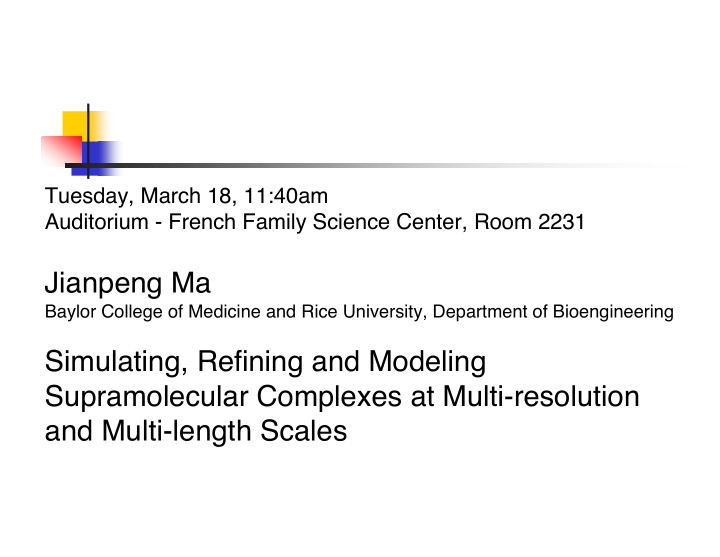



Tuesday, March 18, 11:40am Auditorium - French Family Science Center, Room 2231 Jianpeng Ma Baylor College of Medicine and Rice University, Department of Bioengineering Simulating, Refining and Modeling Supramolecular Complexes at Multi-resolution and Multi-length Scales
Bionanotech - proteins Engineering Design Catalysis Self-assemblies Templates & scaffolds Surface coatings Sensors
Tuan Vo-Dinh, Fitzpatrick Institute for Photonics Nanostructures and self- assemblies Drug delivery Biosensors Molecularly imprinted polymers Humana Press
Protein Nanotech Engineered assemblies Organization of nanomaterials Biosensors Biomineralization Biological Species Example Typical size MW (daltons) Small protein Chymotrypsin 4 nm sphere 10 4 -10 5 Large protein Asp.transcarb. 7 nm sphere 10 5 -10 7 Small assembly Ribosome 20 nm sphere 10 5 -10 7 Large assembly Viruses 100 nm sphere 10 7 -10 12 Nucleic acids tRNA 10 nm rod 10 4 -10 5
Protein Design De novo design vs. library selection Felix, Beta-bellin (Richardsons) α 4 (DeGrado) TOP7 (David Baker) Computational Function Design (Hellinga) Sequenomics (Schultes, LaBean)
Protein arrays 6x5x4 nm biotin 7x7x5 nm biotin streptavidin streptavidin L-rhamnulose-1-phosphate aldolase
Protein arrays
Protein arrays
Protein arrays
Protein arrays
Protein arrays
Bionanotech - proteins Engineering Design Catalysis Self-assemblies Templates & scaffolds Surface coatings Sensors
Chaperonin arrays Chaperonins Natural function: protein folding assistants or actually misfolding “inhibitor”. Heat-shock protein. Multimer assembles given ATP & Mg ++ ; large internal cavity. 15 - 20 nm assemblies. Sulfolobus shibatae Lives in geothermal hot-springs (85°C, pH 2). Theromstable protein easy to purify and engineer. Sequence & structure available for modeling. Assembles into higher order structures (2D crystals).
Chaperonin arrays HSP60 beta 9 nm pore 3 nm pore
Chaperonin arrays
Chaperonin arrays XEDS
S-layer arrays Crystalline bacterial cell surface layers. ~5x10 5 monomers/cell Biosynth ~500 copies/sec Purified S-layer proteins self-assemble into arrays. Pores and functional groups available for engineering.
S-layer arrays
S-layer arrays p4 p4 p6
S-layer arrays
S-layer arrays
S-layer arrays Diversity of: Geometry Pore size pI Glycosylation sites Etc.
S-layer arrays
S-layer arrays
S-layer arrays UV mask S-layer
Bionanotech - proteins Engineering Design Catalysis Self-assemblies Templates & scaffolds Surface coatings Sensors
Self-assembling peptide templates
Self-assembling peptide templates
Metal nanowires from peptide templates
Metal nanowires from peptide templates
Metal nanowires from peptide templates
Metal nanowires from peptide templates
Metal nanowires from peptide templates
Bionanotech - proteins Self-assemblies Templates & scaffolds Nanoparticles Metals Silica, minerals, ceramics, semiconductor Surface coatings
Most Materials are “Biohostile” AFFINERGY Site-Specific Biological Delivery Systems Daniel Kenan www.affinergy.com
Interfacial Biomaterials (IFBM) Objective: Attach a specific biological material Identify peptide that binds to (cell, antibody, protein, etc.) biological material w/ high affinity and selectivity Use a small linker to tie to... IFBM Coating the two peptides together Identify peptide that binds to A synthetic synthetic material w/ high material affinity (plastics, metals, glass, etc.)
IFBMs Configured as Cell Attractants Polystyrene Binding Peptide Synthesized with RGD FFPSSWYSHLGVLSSGRGD
Titanium orthopedic screw with Stem Cells IFBM Attachment of preadipocytes IFBM Blocking
IFBM’s Mediate Rapid & Efficient Cell Adhesion on Ti - IFBM, 10’ + IFBM, 10’
Mineralization of IFBM-Supported Stem Cells at 45d
IFBM Platform IFBM Discovery • Growth Factors Platform: • Cell Receptors > 4 billion peptides • Cell Matrix Proteins Cells in libraries • Collagen Proteins • Enzymes 3 to 6 month cycle to • Antibodies find binders Drugs Peptides Binders found for every target tried Biases can be built into selection Range of affinities • Titanium and specificities can • Stainless Steel be exploited • Teflon • PET, PETG, PGA • Polystyrene • Polycarbonate • Glass, Nylon, Latex
Rapid Solutions Due to Modularity of Affinergy’s Platform Cells Ang1 Tie 2 Growth Factors Cell Receptors tPA New Targets Ang2 Modulators Stainless DES ePTFE Chrome Cobalt Collagen Resorbables Damaged Steel Nitinol Synthetic Scaffolds Heart Tissue
Bionanotech - proteins Engineering & design Custom catalysts Self-assemblies Nano organizers Templates & scaffolds Surface coatings Nanoimprint or DPN inks Tissue regeneration Sensors Sensitivity & selectivity
Molecularly Imprinted Polymers “Artificial proteins” Mimic protein functions Molecular recognition (binding) Catalysis Higher stability Manufacture greater quantities
Molecularly Imprinted Polymers
Molecularly Imprinted Polymers
Recommend
More recommend